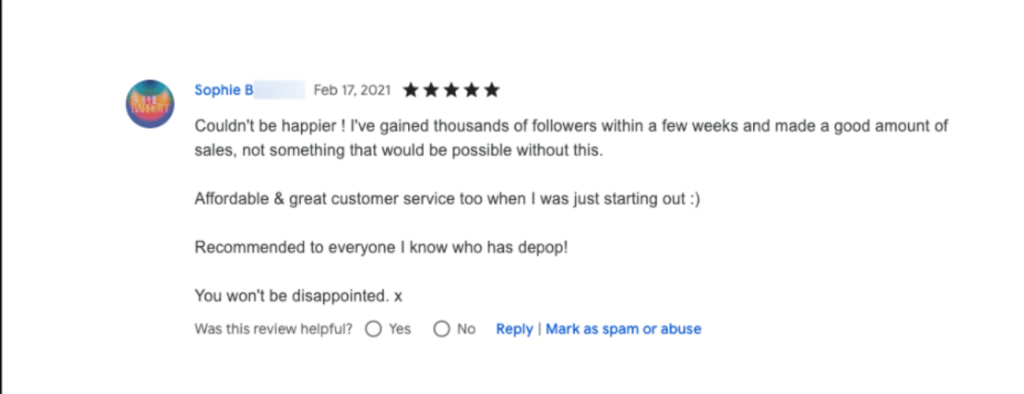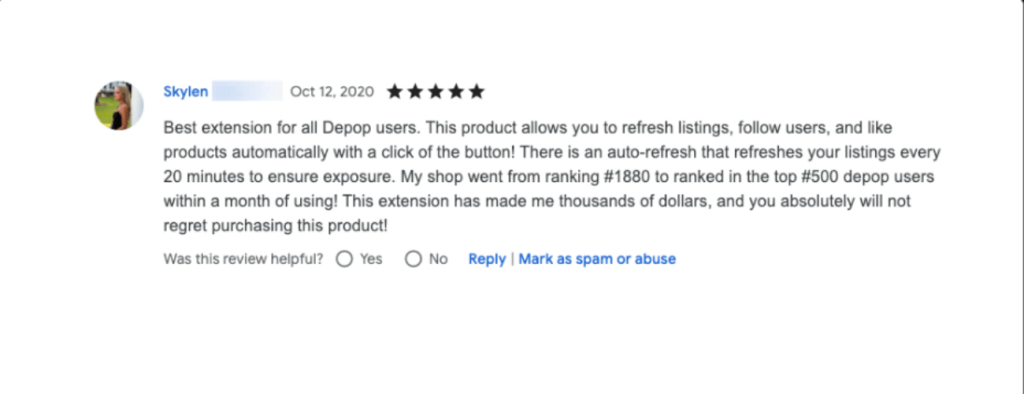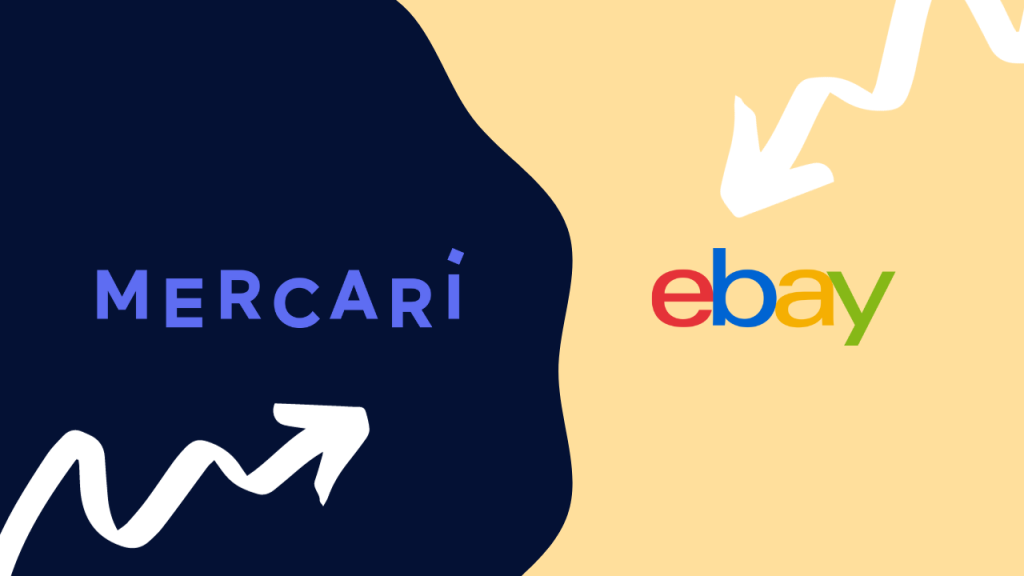The ultimate battle of the marketplace giants!
Both prominent contenders, they each come with their own unique features and challenges.
Have you found yourself constantly seeking the ideal platform to maximize your profits?
The key to your journey of exploration is understanding the differentiating factors between the two platforms, as it is only then you will be able to make an informed decision for your business needs.
You don’t need to look any further.
In this article, we have gathered all the up-to-date information you will need to understand the distinctions between those marketplaces.
From their seller fees to their returns policy, the following Mercari vs eBay review will have you feeling confident in your next steps.
- Overview & Statistics
- Seller Fees
- Listing Process
- Returns & Refunds
- Shipping
- Seller Tools
- The Ultimate Seller Tool: Crosslister
- In Conclusion…
Mercari vs eBay: Overview & Statistics
Before diving into the nitty-gritty details of these popular marketplaces, let’s take a closer look at some recent statistics you may not have encountered before.
What is Mercari?
Founded in Japan in 2013, this online marketplace is perfect for resellers looking to make a profit off new or pre-loved items.
With over 20 million active users every month, the platform has attracted sellers and buyers alike with its user-friendly interface.
According to the latest statistics, over 350,000 listings are made on a daily basis, and these are expected to grow according to Mercari’s Reuse Report– which found that 82% of the adult population in the US have shopped second-hand in 2022.
Currently, the app only ships within the US and Japan.
Although most products sell well on the platform, Mercari is known for its large niche of collectibles.
So, if you are harbouring valuable limited-edition items, this is the right place for you to optimize your earnings!
Find out more: Is Mercari Legit?
What is eBay?
Founded in the United States in 1995, eBay is the is the second-largest online marketplace on a global scale.
With over 138 million active users, this platform is available in over 200 countries, making it one of the best places to reach a wide audience of buyers.
Similar to Mercari, eBay has a product category for pretty much anything- just on a much larger scale!
Its unique auction style system has attracted many resellers wanting the best ROI for their limited-edition and rare collectibles.
Although the marketplace can be difficult to navigate for new users, eBay’s infamous customer support and seller tools continue to set it apart.
Mercari vs eBay: Seller Fees
Comparing those pesky platform fees can be a great deciding factor for the best ecommerce to host your business.
Mercari’s Fees
You will be glad to hear that Mercari does not charge its users any fees for making a listing or setting up your shop.
What a relief, right?!
Instead, the platform makes most of its profits from successful sales. This is why their fees are only incurred after each transaction.
Their fees are split into selling (10%) and payment processing fees (2.9% + $0.50). These are automatically deducted from every individual sale.
Check out our free Mercari Calculator to discover your estimated profits after fees.
All in all, Mercari allows its sellers to make an unlimited number of listings without having to worry about extra costs before a sale has even taken place.
After all, you’re there to make money, not give it all away!
Find out more about Mercari’s fees: Mercari Fees- A Seller’s Guide
eBay’s Fees
Many new users struggle with the complexity of eBay’s fees for sellers.
To begin with, eBay offers several subscriptions– also known as stores- that come with different features and prices.
When you first sign up, you will automatically be placed on a free plan. However, there’s various eBay store packages you may be interested in:
- Starter ($7.95/month)
- Basic ($27.95/month)
- Premium ($74.95/month)
- Anchor ($349.95/month)
- Enterprise ($2,999.95/year)
Find out more: eBay Store Subscriptions
Apart from the optional subscription fees you may choose to be subject to, we have broken down the marketplace’s main fees into two categories:
- Insertion fees
Also known as listing fees, these are incurred after you have surpassed your monthly allocation of 250 free listings.
After this, you will be charged $0.35 per additional listing and category.
In other words, if you make the same listing in two categories, you will be charged separately for each.
Note that even if your item never sells, this charge is non-refundable.
- Final Value fees
This fee is incurred after each successful sale, and it includes handling charges, sales tax, shipping costs and other applicable fees.
It also isn’t fixed, so it slightly varies from category to category. For most categories, this is split into a percentage of the total amount of the sale + $0.30.
Make sure to check out eBay’s guide on Selling Fees for the exact percentages.
For most orders up to $7,500, the final value fee comes to 13.25%.
For anything over $7,500, you will be charged 2.35% on the portion of the sale.
Check out our free eBay Calculator to find out your estimated profits after insertion fees, final value fees and any other listing upgrade fees that may apply.
Mercari vs eBay: Listing Process
Each platform takes a unique approach to creating a listing.
On one hand, Mercari’s easy listing process makes the addition of a new listing possible in just a few minutes.
On the other hand, eBay is known for its myriad of required fields, yet the end result may be worth it- as sellers are supported with various tools to help them on their journey.
Listing on Mercari
Mercari is widely known for its simplicity and user-friendly interface.
In accordance with this, their listing process is straightforward and should only take a few minutes of your time.
- Upload your images
The platform has a limit of 12 photos per listing. For the best results, make use of your allowance by taking high quality, well-lit pictures from different angles to really showcase your product to potential buyers.
Note that Mercari does not support video formats at the moment.
- Write your product description
An informative, yet concise product description is key for grabbing your audience’s attention. Rather than rambling about your product, simply state its features and benefits, along with important details such as brand name and condition.
- Fill in details about your item
Here, you will be required to state your listing’s category, brand, condition, shipping details and price.
Overall, Mercari’s listing process is quick, easy and doesn’t require prior knowledge of selling.
Listing on eBay
Mercari’s simple listing process is certainly unmatched.
However, despite eBay’s elaborate process, it incentivizes its users with more features, a wider audience and better seller tools.
With its countless listing fields, to create a listing you should:
- Add your item photos (and video!)
eBay has a maximum of 24 images and one video per listing- the largest photo allowance of any other ecommerce platform.
This is a great opportunity to visually showcase your product’s features.
After all, a picture is worth a thousand words!
- Fill in your item specifics
Required fields such as the condition, brand, color, size, style and product description will need to be included.
Remember to incorporate popular keywords top sellers are using to increase relevance and boost visibility!
Mercari vs eBay: Returns & Refunds
The return policy of a marketplace can have a direct effect on a seller’s costs and reputation, making it a crucial consideration before signing up with either platform.
Mercari’s Return Policy
Mercari has strict guidelines when it comes to return requests.
Once a buyer has received their order, they only have 3 days to accept the purchase or request a refund. Any requests outside the three-day period will be rejected.
A seller then has 24 hours to review the buyer’s request for a return. This feedback will be used by Mercari to decide if a refund is the best course of action.
If denied, you will receive the payment for the order immediately. Alternatively, the buyer will have 3 days to ship their item back and receive their refund.
Items that are eligible for return include:
- Not as described
- Item is prohibited
- Undisclosed damage to the item
- Seller has not shipped the item
- Incorrect and/or missing item
BONUS: Mercari pays for the return shipping, so you won’t have to worry about any money coming out of your pocket.
eBay’s Return Policy
Taking a unique approach to refund requests, eBay encourages you to set up your own return policy– as long as it complies with their Buyer Protection policy, which states that all returns within reason must be accepted.
Make sure to carefully go through eBay’s guide on setting up your return rules.
Due to eBay’s Money Back Guarantee policy, which ultimately is a buyer protection policy, it is not advisable to reject return requests, as a lot of the time eBay will be able to enforce them on the buyer’s behalf.
A less restrictive returns policy will attract more buyers, making this approach more customer friendly!
Mercari vs eBay: Shipping
A platform’s shipping policy can significantly affect a seller’s ability to provide a great customer experience; thus picking the right platform is important for a profitable business.
Mercari’s Shipping Policy
What Mercari lacks in audience numbers, it makes up for in fast, local delivery.
There’s currently three options to choose from:
- Prepaid Label
Covered by Mercari’s Shipping Protection, this is the recommended option for most sellers. The marketplace is currently partnered with USPS, UPS, and FedEx.
- Ship on your own
Although you have the freedom to choose a more cost-effective shipping service, keep in mind that this option is not covered by Mercari’s Shipping Protection. This policy provides cover for up to $200 in case of a lost or damaged product during transit.
With contact-free delivery, your item is picked up by a driver and delivered directly to your buyer’s doorstep- all on the same day!
Mercari is partnered with Uber and Dolly for this shipping option, and their delivery fees are lower than you’d expect!
This option is also covered by Shipping Protection AND you will receive your payment a lot faster than standard shipping!
eBay’s Shipping Policy
Just like its return policy, eBay’s shipping policy is one characterized by flexibility.
With its integrated shipping carriers, the platform is partnered with a long list of carriers, some of which include UPS, USPS, FedEx, DHL, OnTrac, Lasership, Spee-Dee Delivery and Lone Star Overnight.
These diverse shipping solutions are perfect for a cost-effective experience, as you can alternate between shipping carriers based on your parcel’s weight, size and buyer’s location for the best deal.
Keep in mind that the seller is responsible for the purchase of a shipping label– which is a blessing in disguise, as it can reduce the overall shipping costs!
Mercari vs eBay: Seller Tools
Seller tools are essential for businesses to optimize their performance and remain at the top of the competition in their respective marketplace.
Mercari’s Features
The popular platform offers several easy-to-navigate features to help improve their sales:
Becoming a Pro Seller gives you access to exclusive tools such as enhanced seller analytics, free promotions on third-party networks and advanced inventory management.
In order to receive this badge of honour, you need to earn Mercari’s trust by consistently offering great customer service and showing proof of registration and taxes in the US.
While this is a useful tool, it is not accessible to every seller; in fact you have to join a waiting list!
This truly ‘smart’ feature allows sellers to set a minimum price for their listing.
To put it simply, it automates the negotiation process between seller and buyer by automatically accepting an offer or sending a one-time counteroffer.
eBay’s Features
With high expectations from the second-largest marketplace in the world, eBay comes with a lot of features that are aimed at helping sellers become successful.
This marketing tool helps sellers that have an eBay store subscription to set up various offers on their front.
These include:
- Order discounts
- Coupons
- Shipping discounts
- Sale events
- Volume pricing discounts
Studies have shown that recipients of promotional products have a significantly more positive image of the seller compared to those who didn’t receive promotional products.
Therefore, this feature is great for driving repeat purchases and boosting visibility overall.
This tool allows sellers to create reusable listing templates, saving you a ton of time during the listing process.
These templates are easy to revise, rename or delete and can make information delivery more consistent on your listings.
The Ultimate Seller Tool: Crosslister
Crosslister is a Chrome extension that can help you list your items on multiple marketplaces at once.
You probably landed here wondering which platform is better: Mercari or eBay?
With Crosslister, you don’t have to make a choice- you can have the best of both worlds!
Crosslisting has been shown to increase repeat purchases, promote brand awareness and maximize profits.
It is also a great backup solution if things don’t work out on one marketplace, as your profits don’t solely depend on that singular platform.
Crosslister offers several features:
- Automatically crosslists listings to marketplace of your choice individually or in bulk
- Automatically delists product listings that have been sold on all marketplaces
- Provides you with a single place to manage all your inventory across all marketplaces
- Optimizes your listings to show up at the top of search results
Does this sound too good to be true?
Don’t take our word for it!


On top of 24/7 customer support, using Crosslister means that you can have access to the number #1 online seller community, where you can learn from experienced sellers, or even share your own knowledge to help others!
Crosslister is supported by the following marketplaces:
- Depop
- Vinted
- Poshmark
- eBay
- Mercari
- Etsy
- Grailed
- Facebook Marketplace
- Shopify
- Shpock
- & More coming!
FAQ
1. Which platform has lower fees, Mercari or eBay?
Mercari charges a 10% selling fee and 2.9% + $0.50 for payment processing. eBay fees vary based on store subscriptions and categories, typically around 13.25%.
2. Is Mercari easier to list on than eBay?
Yes, Mercari’s listing process is simpler and faster, whereas eBay offers more complex listing fields and advanced tools.
3. Which platform is better for international sales?
eBay supports global sales, while Mercari is limited to the US and Japan.
In Conclusion…
Choosing between Mercari and eBay ultimately depends on your business needs.
Mercari is known for its user-friendly app and is an excellent choice for US based sellers looking to sell items with minimal hassle. However, its geographical limitation may be an issue for those looking for a global audience.
eBay is a useful solution to this, as it gives access to a large international audience. It also offers more flexible policies and elaborate seller tools to help you on your journey to success. However, due to its complex user-interface, it may involve a steeper learning curve for new sellers.
Crosslisting to both platforms at the same time is the perfect way to increase your chances of successful sales, while receiving the benefits each platform has to offer.
Here at SellerAider, we make automation software that helps sellers develop effective marketing strategies and maximize profits for their business.
Try our crosslisting tool for FREE and watch your sales grow!

